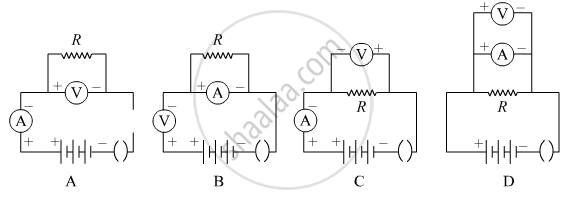Advertisements
Advertisements
Question
How will you conclude that the same potential difference (voltage) exists across three resistors connected in a parallel arrangement to a battery?
Solution
- Take three resistors R1, R2 and R3 and connect them in parallel arrangement as shown in the diagram.

- Connect voltmeter in parallel to measure the potential difference across the combination.
- Now measure the potential difference across the resistor R1 by connecting the voltmeter across it.

- Again, measure the potential difference across the resistor R2 by connecting the voltmeter across it.
- Again, measure the potential difference across the resistor R3 by connecting the voltmeter across it.
- Tabulate all the readings.
It is observed that potential difference reading will be same in all the three cases. This shows that the same potential difference exists across three resistors connected in parallel arrangement to a battery.
APPEARS IN
RELATED QUESTIONS
Name a device that helps to maintain a potential difference across a conductor.
Keeping the potential difference constant, the resistance of a circuit is doubled. By how much does the current change?
The values of potential difference V applies across a resistor and the corresponding values of current I flowing in the resistor are given below:
| Potential differences, V (in volts) | : | 2.5 | 5.0 | 10.0 | 15.0 | 20.0 | 25.0 |
| Current, I (in amperes) | : | 0.1 | 0.2 | 0.4 | 0.6 | 0.8 | 1.0 |
Calculate the power used in the 2 Ω resistor in each of the following circuits: a 6 V battery in series with 1 Ω and 2 Ω resistors.
The differences between the electrostatic potential of the positive end the negative end of an electric cell is the ______ of the cell.
Which one of the following is the correct set-up for studying the dependence of the current on the potential difference across a resistor and why?

Point out two differences between e.m.f. and potential difference as applied to electric circuits.
What do you understand by the resistance of a wire?
Suppose there are three resistors A, B, and C having resistances r1, r2, and r3 respectively. If R represents their equivalent resistance, establish the following relation `1/"R" = 1/"r"_1 + 1/"r"_2 + 1/"r"_3`, when joined in parallel.
A 10 m long wire of a particular material is of resistance 5Ω What will be the resistance if the wire is stretched to double its length?
